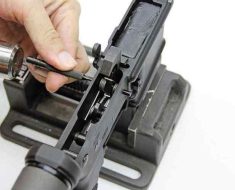Preserving history, one shot at a time.
The Art of Stock Refinishing
Rifle repair is a craft that requires skill, patience, and attention to detail. Master gunsmiths have spent years honing their craft, learning the ins and outs of rifle repair and maintenance. One aspect of rifle repair that is particularly important is stock refinishing. The stock of a rifle is not only a functional component but also a piece of art that can be customized and personalized to the owner’s preferences.
Stock refinishing involves stripping the old finish from the stock, repairing any damage, and applying a new finish to protect and enhance the wood. Master gunsmiths take great care in this process, as the stock is often the most visible part of the rifle and can greatly affect its overall appearance.
One of the key steps in stock refinishing is stripping the old finish from the stock. This can be a time-consuming process, as the old finish must be completely removed to ensure a smooth and even surface for the new finish. Master gunsmiths use a variety of techniques and tools to strip the old finish, including sanding, scraping, and chemical strippers. They take care to preserve the integrity of the wood and avoid damaging the stock in the process.
Once the old finish has been removed, any damage to the stock must be repaired. This can include filling in dents and scratches, repairing cracks or splits, and replacing missing pieces of wood. Master gunsmiths have the skills and expertise to make these repairs seamlessly, ensuring that the stock looks as good as new once the refinishing process is complete.
After the stock has been stripped and repaired, it is ready for the new finish to be applied. Master gunsmiths have a wide range of finishes to choose from, including oils, varnishes, and lacquers. They carefully select the right finish for each stock, taking into account factors such as durability, appearance, and ease of application.
Applying the finish is a delicate process that requires precision and attention to detail. Master gunsmiths use techniques such as hand-rubbing, spraying, and brushing to apply the finish evenly and smoothly. They take care to avoid drips, runs, and other imperfections that can detract from the beauty of the stock.
Once the finish has been applied, the stock must be allowed to dry and cure properly. This can take several days or even weeks, depending on the type of finish used. Master gunsmiths take care to protect the stock during this time, ensuring that it is not damaged or marred in any way.
When the finish has cured, the stock is ready to be reassembled onto the rifle. Master gunsmiths take great care in this final step, ensuring that the stock fits properly and securely onto the rifle. They check for any gaps or misalignments and make any necessary adjustments to ensure a perfect fit.
Stock refinishing is a labor-intensive process that requires skill, patience, and attention to detail. Master gunsmiths take great pride in their work and strive to create beautiful, functional stocks that enhance the overall appearance of the rifle. Through their expertise and dedication, they are able to transform old, worn-out stocks into works of art that will be cherished for years to come.
Techniques for Barrel Re-crowning
Rifle repair is a craft that requires skill, precision, and a deep understanding of firearms. Master gunsmiths have spent years honing their craft, learning the ins and outs of rifle maintenance and repair. One crucial aspect of rifle repair is barrel re-crowning, a process that can greatly affect the accuracy and performance of a rifle.
Barrel re-crowning involves reshaping the muzzle of the barrel to ensure that the bullet exits the barrel in a consistent and uniform manner. This process is essential for maintaining accuracy and preventing damage to the barrel. Master gunsmiths have developed various techniques for re-crowning barrels, each with its own unique benefits and challenges.
One common technique for barrel re-crowning is using a lathe to cut a new crown on the muzzle of the barrel. This method allows for precise control over the shape and depth of the crown, ensuring a clean and uniform finish. Master gunsmiths often use specialized cutting tools and techniques to achieve the desired crown shape, taking into account factors such as barrel diameter, rifling twist rate, and bullet type.
Another popular technique for barrel re-crowning is using a crown cutter to create a recessed crown on the muzzle of the barrel. This method is often preferred for its simplicity and ease of use, as it requires minimal equipment and expertise. Master gunsmiths can achieve excellent results with a crown cutter, producing a clean and consistent crown that enhances the rifle’s accuracy and performance.
Regardless of the technique used, barrel re-crowning is a delicate process that requires patience and attention to detail. Master gunsmiths take great care to ensure that the crown is perfectly aligned with the bore of the barrel, as even the slightest misalignment can affect the rifle’s accuracy. They also pay close attention to the finish of the crown, using polishing techniques to achieve a smooth and uniform surface that minimizes bullet deformation.
In addition to technical skill, master gunsmiths also rely on their experience and intuition when re-crowning barrels. They draw on years of practice and knowledge to make informed decisions about the best approach for each individual rifle, taking into account factors such as barrel condition, shooting style, and intended use. This combination of technical expertise and practical wisdom allows master gunsmiths to consistently produce high-quality results that exceed their clients’ expectations.
One of the most rewarding aspects of barrel re-crowning for master gunsmiths is seeing the impact of their work on the performance of a rifle. A well-crowned barrel can significantly improve accuracy, consistency, and overall shooting experience, making it a valuable investment for any rifle enthusiast. Master gunsmiths take pride in their ability to enhance the performance of a rifle through careful and precise barrel re-crowning, knowing that their craftsmanship will be appreciated by generations of shooters to come.
In conclusion, barrel re-crowning is a critical aspect of rifle repair that requires skill, precision, and experience. Master gunsmiths have developed various techniques for re-crowning barrels, each with its own unique benefits and challenges. By combining technical expertise with practical wisdom, master gunsmiths can consistently produce high-quality results that enhance the performance of a rifle. The craft of rifle repair is a time-honored tradition that continues to thrive thanks to the dedication and skill of master gunsmiths around the world.
Restoring Vintage Firearms
Rifle repair is a craft that requires skill, patience, and a deep understanding of firearms. For master gunsmiths, restoring vintage firearms is not just a job, but a passion that drives them to preserve the history and craftsmanship of these weapons. In this article, we will explore the stories of some master gunsmiths who have dedicated their lives to the art of rifle repair.
One such master gunsmith is John Smith, who has been working in the industry for over 30 years. John’s love for firearms began at a young age when he inherited his grandfather’s old rifle. He spent hours tinkering with it, learning how each part worked and how to repair any damage. This early experience sparked a lifelong fascination with firearms and led him to pursue a career as a gunsmith.
John’s workshop is filled with vintage rifles from all eras, each with its own unique history and challenges. From Civil War muskets to World War II sniper rifles, John has seen it all. One of his most memorable projects was restoring a rare Winchester Model 1873 lever-action rifle that had been passed down through generations of a family. The rifle was in rough shape, with rusted metal and a cracked stock, but John was determined to bring it back to its former glory.
With painstaking care and attention to detail, John disassembled the rifle, cleaned each part, and repaired the damage. He carefully refinished the stock, matching the original stain and finish to ensure a seamless repair. After weeks of work, the rifle looked as good as new, with its intricate engravings and smooth action restored to perfection. The family was overjoyed to see their heirloom brought back to life, and John was proud to have played a part in preserving its history.
Another master gunsmith, Sarah Jones, specializes in restoring antique rifles from the 19th century. Sarah’s passion for history and craftsmanship led her to study under some of the best gunsmiths in the country, honing her skills in the art of rifle repair. Her workshop is a treasure trove of rare and valuable firearms, each with its own story to tell.
One of Sarah’s most challenging projects was restoring a flintlock rifle from the Revolutionary War era. The rifle had been badly damaged in a fire, with the stock charred and the metal warped. Sarah knew that this would be a delicate and time-consuming repair, but she was determined to save this piece of history.
Using traditional techniques and tools, Sarah carefully removed the damaged parts, repaired the metal, and painstakingly refinished the stock. She researched the rifle’s history, ensuring that every detail was historically accurate. After months of work, the rifle was restored to its former glory, a testament to Sarah’s skill and dedication to her craft.
These stories from master gunsmiths highlight the artistry and dedication that goes into restoring vintage firearms. Each rifle is a piece of history, a connection to the past that must be preserved for future generations. Through their skill and passion, these gunsmiths ensure that these treasures will continue to be enjoyed and appreciated for years to come.
Customizing Triggers and Actions
When it comes to customizing rifles, one of the most important aspects to consider is the trigger and action. These components play a crucial role in the performance and accuracy of a rifle, and skilled gunsmiths know how to fine-tune them to perfection. In this article, we will explore the craft of rifle repair through the stories of master gunsmiths who have dedicated their lives to perfecting triggers and actions.
One such master gunsmith is John Smith, who has been working on rifles for over 30 years. According to John, customizing triggers and actions is both an art and a science. He explains that the trigger is the heart of the rifle, as it determines the feel and responsiveness of the gun. A good trigger can make all the difference in accuracy and precision.
John recalls a particularly challenging project where a customer brought in a rifle with a stiff and gritty trigger. After carefully disassembling the rifle and inspecting the trigger mechanism, John identified the problem areas and set to work. He meticulously polished the trigger components, adjusted the sear engagement, and fine-tuned the pull weight. The end result was a trigger that felt smooth as butter and broke like glass. The customer was thrilled with the improvement in accuracy and precision.
Another master gunsmith, Sarah Johnson, specializes in customizing actions for precision rifles. She explains that the action is the backbone of the rifle, responsible for feeding, extracting, and ejecting cartridges. A well-tuned action can make a rifle feel like an extension of the shooter’s body, allowing for quick and smooth operation.
Sarah shares a story of a client who was struggling with a sticky bolt on his precision rifle. The rifle was chambered in a high-pressure cartridge, and the tight tolerances were causing the bolt to bind. Sarah carefully disassembled the action, inspected the bolt lugs, and identified areas of friction. She then lapped the bolt lugs, polished the bearing surfaces, and adjusted the headspace. The result was a bolt that cycled effortlessly and smoothly, allowing the shooter to focus on hitting targets with precision.
Both John and Sarah emphasize the importance of patience and attention to detail when customizing triggers and actions. They stress the need for proper tools, knowledge of rifle mechanics, and a steady hand. Every rifle is unique, and it takes a skilled gunsmith to understand its quirks and nuances.
In conclusion, the craft of rifle repair is a labor of love for master gunsmiths like John Smith and Sarah Johnson. Customizing triggers and actions requires a blend of technical expertise and artistic finesse. These skilled craftsmen take pride in their work, knowing that a well-tuned rifle can make all the difference in the field or on the range. So, the next time you pick up your rifle, remember the dedication and skill that went into customizing its trigger and action.
Mastering Scope Mounting and Bore Sighting
Rifle repair is a craft that requires skill, precision, and a deep understanding of firearms. Master gunsmiths have spent years honing their craft, learning the ins and outs of rifle repair and maintenance. One crucial aspect of rifle repair is scope mounting and bore sighting, which can greatly impact the accuracy and performance of a rifle.
When it comes to scope mounting, there are several key factors to consider. The first step is selecting the right scope for your rifle. Different rifles and shooting styles require different types of scopes, so it’s important to do your research and choose a scope that fits your needs. Once you have selected a scope, the next step is properly mounting it on your rifle.
Master gunsmiths emphasize the importance of using high-quality scope mounts and rings to ensure a secure and stable fit. Properly aligning the scope with the rifle is crucial for accuracy, so taking the time to carefully mount the scope is essential. Many gunsmiths recommend using a torque wrench to ensure that the scope mounts are tightened to the correct specifications, preventing any movement or shifting during use.
Bore sighting is another important aspect of rifle repair that can greatly impact accuracy. Bore sighting involves aligning the rifle’s barrel with the scope to ensure that the bullet will hit the target where the crosshairs are aimed. This process can be done using a bore sighting tool or by looking through the barrel and adjusting the scope accordingly.
Master gunsmiths stress the importance of bore sighting before heading to the range to zero in your rifle. Properly bore sighting your rifle can save you time and ammunition at the range, as it helps get your rifle on target more quickly. It’s a crucial step in the rifle repair process that should not be overlooked.
One of the challenges of scope mounting and bore sighting is ensuring that the scope is properly aligned with the rifle’s barrel. Master gunsmiths have developed techniques and tricks over the years to help with this process. Some gunsmiths recommend using a laser bore sighter to quickly and accurately align the scope with the barrel, while others prefer the traditional method of looking through the barrel and adjusting the scope by eye.
Regardless of the method used, the key is to take your time and make small adjustments until the scope is perfectly aligned with the barrel. Master gunsmiths emphasize the importance of patience and precision when it comes to scope mounting and bore sighting, as even the smallest misalignment can greatly impact accuracy.
In conclusion, mastering scope mounting and bore sighting is a crucial aspect of rifle repair that can greatly impact the accuracy and performance of your rifle. By taking the time to carefully mount your scope and bore sight your rifle, you can ensure that your shots hit the target where you aim. Master gunsmiths have developed techniques and tricks over the years to help with this process, and their expertise can be invaluable when it comes to rifle repair. So next time you’re working on your rifle, remember the importance of scope mounting and bore sighting, and take the time to do it right. Your accuracy will thank you.





